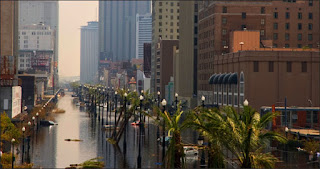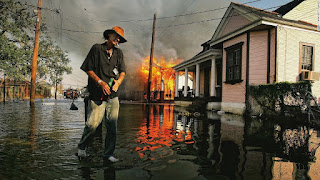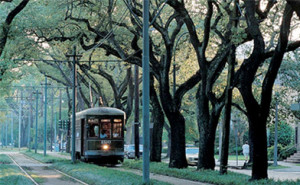Here is a video of President Barack Obama speaking at ceremony to commemorate the Ten Year Anniversary of Hurricane Katrina: https://youtu.be/pJEx-LliwbQ
 |
| Post-Katrina downtown New Orleans, Louisiana circleofblue.org |
It is hard to believe that ten years ago this month, Hurricane Katrina struck nearly submerging the entire city of New Orleans, Louisiana. The images of impoverished residents escaping the rising floodwaters compelled urban planners to flock to the city with dreams of "a more equitable community built on higher ground." However, as Dante Ramos writes in his Boston Globe article, "10 years after Katrina, New Orleans abounds with hard lessons," the reality of creating this dream city went wildly off script. Ten years later, the city is still in the same place but the big news (wait for it) is the proliferation of hipsters and yuppies. Yuppies and hipsters aside, the story is really about the direction post-Katrina New Orleans is going in. Does want to continue waiting for closure or fix what it can and move toward a brighter future?
 |
| Post-Katrina St. Roch Market New Orleans, Louisiana ocw.mit.edu |
As the post-Katrina discussions continued, attention focused on St. Roch Market, "...a St. Claude Avenue landmark where working people once did their food shopping." Mr. Ramos shares his experience of his first visit to the market twenty years ago. He writes, "...but the city pumped $3.7 million into rehabbing the space. Yet instead of an everyday grocery store, St. Roch reopened this spring as a gleaming, high-end gastronomic emporium..." Instead of the every day necessities, the shelves were stock with expensive gourmet foods that seemed an anathema to the residents.
 |
| St. Roch before and after nytimes.com |
In their minds, they wanted it restored to what it used to be, which was an authentic neighborhood market...Ironically, when you added gentrification to that formula, it didn't come back as that.
The revival of St. Roch Market is one real-life conclusion of "...the post-Katrina experiment: uplifting on some level-hipsters equal money equals growth-but anxiety-inducing on another."
 |
| Sustainable home in the Lower Ninth Ward musicforgood.tv |
 |
| Man walking past a burning house in the Seventh Ward cnn.com |
"...otherworldly beauty to the place: not just the blue sky, or the graceful live oaks trees, or the rows of brightly painted Creole homes, but also their reflection on the surface of the murky waters." Poetic description of the aftermath of a hurricane.
Dante Ramos also recalled how the days became increasingly chaotic as residents tried to flee toward higher ground. The images broadcast on television shocked the viewers. "How could the victims, disproportionately poor, elderly, and African-American, have been abandon to their fate in flood-prone areas?"
 |
| Post-Katrina destruction Photograph by Pia Z. Erhardt latimesblogs.latimes.com |
In a strange move by the Bring New Orleans Back Commission, assembled by then-Mayor Ray Negin, individual neighborhoods were called upon to demonstrate their viability, placing symbolic green dot-indicating potential areas for future parkland-over the low-lying Lower Ninth Ward and Broadmoor. The hope was that there would enough federal funds to fuel large-scale relocation to higher ground. In reality, "that was never, ever, going to happen." This country does not have a readily available stash of cash, said Tulane University geographer Richard Campanella. Available stash of cash that can be evenly distributed while all these folks are displaced and wondering what the next chapter of their lives is going to be, Prof. Campanella continues.
 |
| "Katrina was here" Photograph by Richard Campanella placesjournal.org |
Eventually, the Unified New Orleans Plan, that called for the rebuilding in all the neighborhoods, was adopted. Still, it was the same old song and dance. "Homeowners got repair grants that reflected the pre-Katrina value of their homes-hobbling those who owned inexpensive homes but faced stiff renovation costs." An outraged LaToya Cantrell, a Broadmoor community leader now City Council member put it succinctly, Everybody pays the same price for Sheetrock...So why in the hell-if they're building their fifteen hundred square feet and I'm building mine-why would my grant be different?
 |
| Post 119 in Gulfport, Mississippi Katrina before and after post_119_gulfport_ms.tripod.com |
It was this precise problem resulted in a legal settlement, but there were thousands of strings attached. "Did you have clear title to a family property? Did you haggle with insurers?" and so on. It was enough to make someone lose their will to live. Seriously, all this nitpicking was relevant to any social justice issues, but they all conspired against the less affluent. Even today, Ms. Cantrell observes that the majority of African-American homeowners are in limbo, completing some repairs before the money, to finish the job, ran out. There are lessons to be learned from these troubles, Dante Ramos writes, "Superficially neutral rules for insurance and public aid can end up cheating people. Homeowners make decisions less on abstract imperatives-move to higher ground!-than the size of the checks they receive. If neighborhoods are to be abandoned altogether, that'll happen only over decades, not by fiat in a matter of weeks."
When you are not encumbered by unrepairable property, new economic opportunities materialize. In parts of New Orleans that avoided serious flooding, there is a building boom in process, the very same "urban renaissance that's invigorating downtowns from Boston to Los Angeles..." is taking root in New Orleans too. One example, is a vacant former downtown hotel that is finally being renovated.
 |
| Night Market on St. Claude/St. Roch Avenue New Orleans, Louisiana nolavie.com |
Fueling the new commercial corridors is an unexpected influx of money and innovation. New Orleans became a refuge, of sorts, for unemployed college graduates when the global financial crisis hit in 2008. For years, Louisiana politicians bemoaned the continuous brain to Atlanta and Houston. Prof. Richard Campanella told Mr. Ramos, New Orleans today is home to about 40,000 people who never lived in the city before Katrina-probably more than half of them young and college-educated-who've brought with them their own muscle and human capital.
 |
| Trolley car in the Garden District New Orleans stcharlesinn.com |
 |
| Downtown New Orleans; Canal and St. Charles commons.wikimedia.org |
Be that as it may, while New Orleans is great at making true believers out of transplants, the demographic shift inevitably alters the culture in ways that rankle the displaced residents. Mr. Daniel says,
Some of [the new people] don't like loud jazz music in the street...Some of them move next to bars and can't understand why they're open late. Some of the old New Orleanians are like, "Eh"..."I'm not interested. It's not for me."
 |
| Bywater section of New Orleans Pretty self-explanatory forbes.com |
The real question is whether or not New Orleans is better off today than before Hurricane Katrina. The answer depends on who you are. Dante Ramos writes, "If you're young and aesthetically minded, the city feels far more dynamic than ever." St. Claude Avenue, the St. Roch Market, is dotted with trendy bars and restaurants featuring a wide-ranging mix of food and entertainment. Nearby is the casual and unpretentious Faubourg Wines. There is an acupuncture studio and a measurable upswing in bicycle traffic. The bursts of millennial bohemianism along the streets of the Bywater section are hard to ignore. Catherine Markel, the owner of Faubourg said, You see people [who] look like they just walked off the set of "Portlandia."
 |
| Bywater hipsters in costume (?) myneworleans.com |
 |
| The Treme Jazz Band marching through the French Quarter framework.latimes.com |
I'm just doing my thing...There are probably economists and sociologists or anthropologists who are experts and can explain what's going on. I'm just kind of living in it.
New Orleans's current situation is not unique as other cities struggle to regain some equilibrium following great singular disasters that call for grand gestures and collective recovery efforts. However as Dante Ramos succinctly puts it, "...but recoveries are built on how hundreds of thousands of individuals confront a fundamental choice: You spend a decade waiting for closure to come, for justice to be done, for the heartbreak to heal completely. Or you patch things up as much as you can, and hope the future leads to something beautiful."
No comments:
Post a Comment